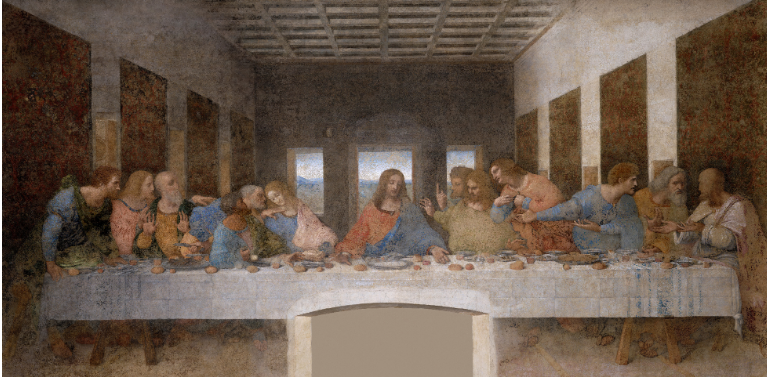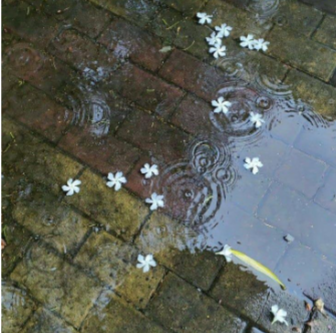On The Path By Alexandra Rae
- Breanna Crossman
- Aug 4, 2023
- 5 min read
Updated: Aug 7, 2023

“On The Path” by Fiona Neary
(@fionarose.art and @fionaneary.artist)
In a coffee shop in downtown Saratoga Springs hangs a painting that, upon one look at its technicolor forest landscape, transports you to elsewhere. This elsewhere may be a similar scene from one’s hometown or an art class taken at seven years old, before the world proclaimed a proclivity towards assimilation and death to creativity, or a place once read about in a story only half-remembered or, if the viewers of this creation are anything like me, they may be taken to a place that is no place at all. A place that is made of childhood wonder and prismatic visions; a place where blank minds can wander down the path of their choosing.
I am of course referring to the painting “On The Path” by Saratoga native Fiona Neary. Her work centers on her fascination with spirituality and nature, which is conveyed through her skillful use of color and abstract-like brush strokes. For art lovers or anyone at all with good taste, I implore you to support her work on social media (@fionarose.art) and discover for yourself all that she creates.
Her piece “On The Path” stuck with me hours after I left the coffee shop in which I found it (Uncommon Grounds, thank you for the best bagel I’ve ever had). I was drawn towards it because I appreciate art in public spaces. But I believe the reason why it resonated with me so much – why this languid scene of two people surrounded by greenery lodged itself into the space between my heart and my brain – is because I’m also an artist, an artist who conjures up words to give you stories. And when I look at the shadow people in Neary’s piece, I see myself traversing into the depths of my own elsewhere, where I can only enter if I stay on the path.
It is not easy to constantly create in a world filled with so much distraction. And tragedy. And chaos and – wait, did you hear about those poor elephants? What about the monkeys? No, not those monkeys. The other monkeys, the ones – oh wait, before I tell you this, didn’t you hear the news about climate change? Or the strikes, all 6,000 of them that the CEOs continue to ignore? Or the book that became a movie that’s becoming a series that people loved but now hate? Or the freak accident on Highway 999 that killed twelve but spared one? Didn’t you? Didn’t you?
You see what I mean?
To stay entirely focused on your craft despite these diversions is to be part of a rare breed of artists. It is no longer part of the artistic process (this “It” referring to utter concentration; dedication; a stream of consciousness so torrential that the human vessel has no choice but to bring their ideas to life) that is supposed to take part in the everyday life of the creative, but, rather, it is something that the creative must be constantly reaching for beyond the noise that our own inventions, interests and desires bring. There are now creators telling creators how to keep creating; how to block out the creations of other creators that block our own creativity. It is these distractions that have become a relentless cycle of nothingness and overstimulation at the same time. It is they that have the power that us artists are supposed to have.
And let’s say the artist breaks free from these distractions – let’s say they avoid the news, meditate in a field of dandelions, move to a cottage in the countryside and throw their phone out the car window on the way. Let’s say they find their path again in a random alleyway in the city while bar hopping with their friends, or down the staircase in their grandparents’ basement where their old finger paintings are kept, or, like Neary’s shadow people, in a forest where elsewhere is a promise down the path. Let’s say they find their elsewhere and pull from it the art they’ve been trying to create for months. Once the stuff of their elsewhere is thrown out into the world, what follows?
If there is silence, the artist feels like they’ve failed in some way. The artist may question what, or who, they are really creating for: themselves or the world? If there is praise, the artist may feel like they will never create anything that will result in such approval again. But isn’t creating “bad” art with no one to appreciate it part of being an artist? It is a confusing thing, to want others to validate your life’s work while also promising yourself that everything you create is for the action of creation itself; for your child self’s dreams. This is the paradox of the human experience: to want to share your life with others while yearning for a life that is entirely your own.
And sometimes there are people who love the artist’s work, but can’t help to ask, “So what do you really do?” By this they mean what corporation you work for to pay the rent and put food on the table, because there is no conceivable way that you possess enough talent or determination to rely on your artistry to live – to be an artist full time. It is not these individuals that are at fault for perpetuating the common disregard for the artist as anything more than a hobbyist; it is our society as a whole that seeks to place doubt on what the artist is capable of.
But, sometimes, the artist begins to ask themselves the same question. They listen to the echoing silence or feel too much pressure from the applause, and they decide a life of creativity is no longer for them. They pack away their paint brushes and pens and vow to take themselves seriously for now on. They get a job at the same place their father worked and talk about the stock market with their coworkers over lunch. They accept The American Dream as their own and forget the days when they promised themselves to be more than this. The artist is no longer an artist; they have left their path for one marked with thousands of other footsteps of those that came before them.
It is imperative for the artist, and by this I mean all artists, to never leave their path. That silence you hear is space for you to reflect and continue creating what speaks to you. That praise you receive is confirmation that you have the ability to create things that speak to others. Those questions you are asked do not seek answers, they seek conformity; fear; resignation from what you truly desire. I implore you to reject them. I implore you to stay on your path.
This isn’t to say I advise risking financial insecurity and a roof over your head. It’s to say I believe in the power of the artist in our age of turbulence and distraction; hustle culture and pipedreams. I believe artists should do whatever they can to continue making their art – to reach into the depths of their elsewhere to create something beautiful. And if they can, stay there for a while.
This is where I have been, or would like to be, or am trying to be. Where the mundane of the real world slips away like sand, or time, or the dreams we have before we wake up, and the fantastical, the whimsical, the kind of magic we all thought was real as children comes to hold my hand and guide me down my chosen path. Fiona Neary created “On The Path” because she never left her own. I’m here because I chose to do the same. Alexandra Rae (she/her) is a 20-year-old aspiring writer from the U.S. studying Creative Writing and Public Relations & Advertising at Point Park University. She loves exploring all genres, but her favorites are Creative Non-Fiction and Poetry. She is also a content writer for The Young Writer's Initiative (@TYWI on Instagram) and runs her own writing account as well
(@theresonationofalexandra). Her biggest writing inspirations are Taylor Swift, Lauren Slater, Stephen King, and Joy Harjo.



Comments